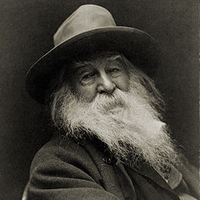Song of Myself Section 52 by Walt Whitman: Summary and Analysis
There are five or six phases the development of ideas in the poem; the speaker (the unenlightened rough American of section 1) passes through these phases of experience and change. In short, the phases are as follows:

Walt Whitman (1819-1892)
1) The common man, different from others only with his uncommon sense of wonder towards his surrounding and his fellow beings; 2) gradually enters a kind of awakening, mystical experience, experienced awakening, at least in thought; 3) illumination and mystical experience, along with the acceptance of sensuality; 4) the 'night of the soul', or the intense suffering due to the realization of the suffering of other human beings, and a spiritual purification; 5) the preparing to leave, after having realized the transcendence of life. From section 51 itself, the cycle of the poem moves towards completion; and section 52 cycle of the poem begins to declare how the speaker takes leave from his human form to enter the great cycle of immortal/eternal life back in the nature as a part of it. He will now become one with the leaf of grass, as common and natural and as undying but ever changing. The poet like each component of the universe has completed a phase of the great evolutionary process. At last he tells the reader he will take just another form and go on living, most likely in the form of grass. There is no "death" for Whitman, no ultimate "dissolution". He will fuse with the pantheistic "grass", the symbol of eternal and reincarnating life. The poem ends by having developed the theme of transcendence and also having applied it to the poet's own case. He is transcending life, and that is why, as we understand now, he was celebrating it in the beginning of the poem.
Site this Page!
Shrestha, Roma. "Song of Myself Section 52 by Walt Whitman: Summary and Analysis." BachelorandMaster, 21 Mar. 2018, bachelorandmaster.com/britishandamericanpoetry/song-of-myself-summary-analysis-of-section-52.html.
Related Topics
The World Below the Brine: Analysis
When Lilacs Last in the Dooryard Bloom'd: Analysis
Crossing Brooklyn Ferry: Summary
Crossing Brooklyn Ferry: Analysis
Song of Myself (Section 1: Summary & Analysis)
Song of Myself (Section 6: Summary & Analysis)
Song of Myself (Section 11: Summary & Analysis)
 |
bachelorandmaster.com |